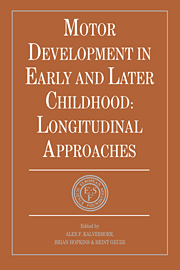Book contents
- Frontmatter
- Contents
- List of contributors
- Foreword
- Preface
- SETTING THE SCENE
- SECTION I BIOLOGICAL BASIS OF MOTOR DEVELOPMENT
- SECTION II DEVELOPMENT OF BODY POSTURE AND GOAL-DIRECTED REACHING
- 6 Early postnatal development of posture control: normal and abnormal aspects
- 7 Studying the development of goal-directed behaviour
- 8 Development of motor functions: a ‘developmental neurological’ approach
- SECTION III MOTOR DEVELOPMENT, EARLY COMMUNICATION AND COGNITION
- SECTION IV ACQUISITION OF SKILLS
- SECTION V MOTOR DEVELOPMENT AND HANDICAP
- SECTION VI METHODOLOGICAL AND CONCEPTUAL CONSIDERATIONS
- Epilogue: description versus explanation
- Index
8 - Development of motor functions: a ‘developmental neurological’ approach
from SECTION II - DEVELOPMENT OF BODY POSTURE AND GOAL-DIRECTED REACHING
Published online by Cambridge University Press: 05 May 2010
- Frontmatter
- Contents
- List of contributors
- Foreword
- Preface
- SETTING THE SCENE
- SECTION I BIOLOGICAL BASIS OF MOTOR DEVELOPMENT
- SECTION II DEVELOPMENT OF BODY POSTURE AND GOAL-DIRECTED REACHING
- 6 Early postnatal development of posture control: normal and abnormal aspects
- 7 Studying the development of goal-directed behaviour
- 8 Development of motor functions: a ‘developmental neurological’ approach
- SECTION III MOTOR DEVELOPMENT, EARLY COMMUNICATION AND COGNITION
- SECTION IV ACQUISITION OF SKILLS
- SECTION V MOTOR DEVELOPMENT AND HANDICAP
- SECTION VI METHODOLOGICAL AND CONCEPTUAL CONSIDERATIONS
- Epilogue: description versus explanation
- Index
Summary
INTRODUCTION
The study of postural development (Woollacott, Chapter 6, this volume) and of early development of manual action (von Hofsten, Chapter 7, this volume) are two fields of research that might profit from a ‘developmental neurological’ discussion, since facts from basic neurosciences can at present be linked to observations in normal human development and to some findings in specific disease conditions. Before discussing these aspects, this chapter starts with a short comment on definitions and concepts.
DEFINITIONS AND CONCEPTS
Woollacott (Chapter 6, this volume) starts by describing posture and postural control more or less as ‘pre-requisites’ for other programmes such as voluntary movements, cognitive tasks and communication. The definitions of postural control and posture as such are not given but Woollacott uses ‘independent stability and motility’. In the section on the neonate she supports a more integrated view of Bullinger & Jouen (1983): ‘organization of the neonate's movements is part of a global form of postural control, involving the entire body’. In the discussion on the newly sitting child, the ‘postural response synergies’ derived from surface electromyographic studies are considered as ‘not innate but emerging gradually with experience of sitting’. In the section on the standing child a discussion is introduced on some of the interacting postural mechanisms, such as 'activation of postural responses by the visual system and finally in the discussion of locomotion and reaching the concept of posture as a ‘prerequisite’ is elaborated. Posture becomes an integral part of a motor task in the longitudinal study of von Hofsten & Woollacott (1989) on the development of reaching in sitting infants.
- Type
- Chapter
- Information
- Motor Development in Early and Later ChildhoodLongitudinal Approaches, pp. 125 - 135Publisher: Cambridge University PressPrint publication year: 1993



